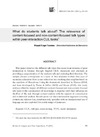Identificador persistente para citar o vincular este elemento:
https://accedacris.ulpgc.es/jspui/handle/10553/12253
| Campo DC | Valor | idioma |
|---|---|---|
| dc.contributor.author | Fuentes, Miquel Ángel | en_US |
| dc.date.accessioned | 2014-10-01T02:30:42Z | - |
| dc.date.accessioned | 2018-03-15T14:28:08Z | - |
| dc.date.available | 2014-10-01T02:30:42Z | - |
| dc.date.available | 2018-03-15T14:28:08Z | - |
| dc.date.issued | 2013 | en_US |
| dc.identifier.issn | 1133-1127 | en_US |
| dc.identifier.uri | https://accedacris.ulpgc.es/handle/10553/12253 | - |
| dc.description.abstract | This paper observes the different talk types that occur in an instance of peer interaction in Science through English CLIL classroom and attempts at providing a categorization of the students talk and analyzing their function. The sample chosen corresponds to a team of five students in their first year of secondary education from a state school set in a working class neighborhood on the outskirts of Barcelona. Using the framework described by Mercer (2004) and later developed by Pierce & Gilles (2008) and Moate (2011), this study analyzes what the impact of different content-focused and non-content-focusedtalk types in the construction of knowledge is, together with their influence onthe flow of the task through content analysis with the support of conversation and multimodal analysis. Results point out that conversation segments covering content are relevant but, simultaneously, episodes with an interpersonal use of language are also exploited for a wide range of purposes. | en_US |
| dc.format | es | |
| dc.language | eng | en_US |
| dc.relation.ispartof | LFE. Revista de Lenguas para Fines Específicos | en_US |
| dc.source | LFE. Revista de Lenguas para Fines Específicos [ISSN 1133-1127], n. 19, p. 80-108 | en_US |
| dc.subject | 570107 Lengua y literatura | en_US |
| dc.subject | 550510 Filología | en_US |
| dc.subject.other | CLIL | en_US |
| dc.subject.other | Talk-types | en_US |
| dc.subject.other | Science learning | en_US |
| dc.subject.other | TEFL | en_US |
| dc.subject.other | Teacher development | en_US |
| dc.title | What do students talk about? The relevance of content-focused and non-content-focused talk types within peer-interaction CLIL tasks | en_US |
| dc.type | info:eu-repo/semantics/article | en_US |
| dc.type | Article | en_US |
| dc.compliance.driver | 1 | es |
| dc.identifier.absysnet | 233536 | - |
| dc.description.lastpage | 108 | en_US |
| dc.description.firstpage | 80 | en_US |
| dc.investigacion | Artes y Humanidades | en_US |
| dc.rights.accessrights | info:eu-repo/semantics/openAccess | es |
| dc.type2 | Artículo | en_US |
| dc.utils.revision | Sí | en_US |
| dc.identifier.ulpgc | Sí | en_US |
| dc.description.esci | ESCI | |
| dc.description.dialnetimpact | 0,0 | |
| dc.description.dialnetq | Q2 | |
| dc.description.erihplus | ERIH PLUS | |
| item.fulltext | Con texto completo | - |
| item.grantfulltext | open | - |
| Colección: | LFE, Rev. leng. fines específ. n.19, 2013 Artículos | |
Visitas
111
actualizado el 14-dic-2024
Descargas
47
actualizado el 14-dic-2024
Google ScholarTM
Verifica
Comparte
Exporta metadatos
Los elementos en ULPGC accedaCRIS están protegidos por derechos de autor con todos los derechos reservados, a menos que se indique lo contrario.
